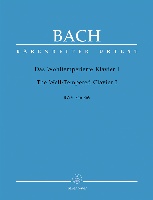The St. Matthew Passion (also frequently but
incorrectly referred to as St. Matthew's Passion;
German: Matthäus-Passion), BWV 244 is a Passion, a
sacred oratorio written by Johann Sebastian Bach in
1727 for solo voices, double choir and double
orchestra, with libretto by Picander (Christian
Friedrich Henrici). It sets chapters 26 and 27 of the
Gospel of Matthew (in the German translation of Martin
Luther) to music, with interspersed chorales and arias.
It is widely regarded as one of the master...(+)
The St. Matthew Passion (also frequently but
incorrectly referred to as St. Matthew's Passion;
German: Matthäus-Passion), BWV 244 is a Passion, a
sacred oratorio written by Johann Sebastian Bach in
1727 for solo voices, double choir and double
orchestra, with libretto by Picander (Christian
Friedrich Henrici). It sets chapters 26 and 27 of the
Gospel of Matthew (in the German translation of Martin
Luther) to music, with interspersed chorales and arias.
It is widely regarded as one of the masterpieces of
classical sacred music. The original Latin title Passio
Domini nostri J.C. secundum Evangelistam Matthæum
translates to "The Passion of our Lord J[esus] C[hrist]
according to the Evangelist Matthew"
Bach did not number the sections of the St Matthew
Passion, all of them vocal movements, but
twentieth-century scholars have done so. The two main
schemes in use today are the scheme from the Neue
Bach-Ausgabe (NBA, New Bach Edition) which uses a 1
through 68 numbering system, and the older
Bach-Werke-Verzeichnis (BWV, Bach Works Catalog) scheme
which divides the work into 78 numbers. Both use
lettered subsections in some cases.
Many composers wrote musical settings of the Passion in
the late 17th century. Like other Baroque oratorio
passions, Bach's setting presents the Biblical text of
Matthew 26–27 in a relatively simple way, primarily
using recitative, while aria and arioso movements set
newly written poetic texts which comment on the various
events in the Biblical narrative and present the
characters' states of mind in a lyrical, monologue-like
manner.
The St Matthew Passion is set for two choirs and two
orchestras. Both include two transverse flutes (Choir 1
also includes 2 recorders for No. 19), two oboes, in
certain movements instead oboe d'amore or oboe da
caccia, two violins, viola, viola da gamba, and basso
continuo. For practical reasons the continuo organ is
often shared and played with both orchestras. In many
arias a solo instrument or more create a specific mood,
such as the central soprano aria No. 49, "Aus Liebe
will mein Heiland sterben", where the absence of
strings and basso continuo mark a desperate loss of
security.
The Passion was written for two choruses and
orchestras. Choir I consists of a soprano in ripieno
voice, a soprano solo, an alto solo, a tenor solo, SATB
chorus, two traversos, two oboes, two oboes d'amore,
two oboes da caccia, lute, strings (two violin
sections, violas and cellos), and continuo (at least
organ). Choir II consists of SATB voices, violin I,
violin II, viola, viola da gamba, cello, two traversos,
two oboes (d'amore) and possibly continuo.
Source: Wikipedia
(https://en.wikipedia.org/wiki/St_Matthew_Passion).
I created this arrangement of the Recitative: “Und
wiewohl viel falsche Zeugen herzutraten” (And
although many false witnesses came forward) for Concert
(Pedal) Harp.





 Faire un don
Faire un don